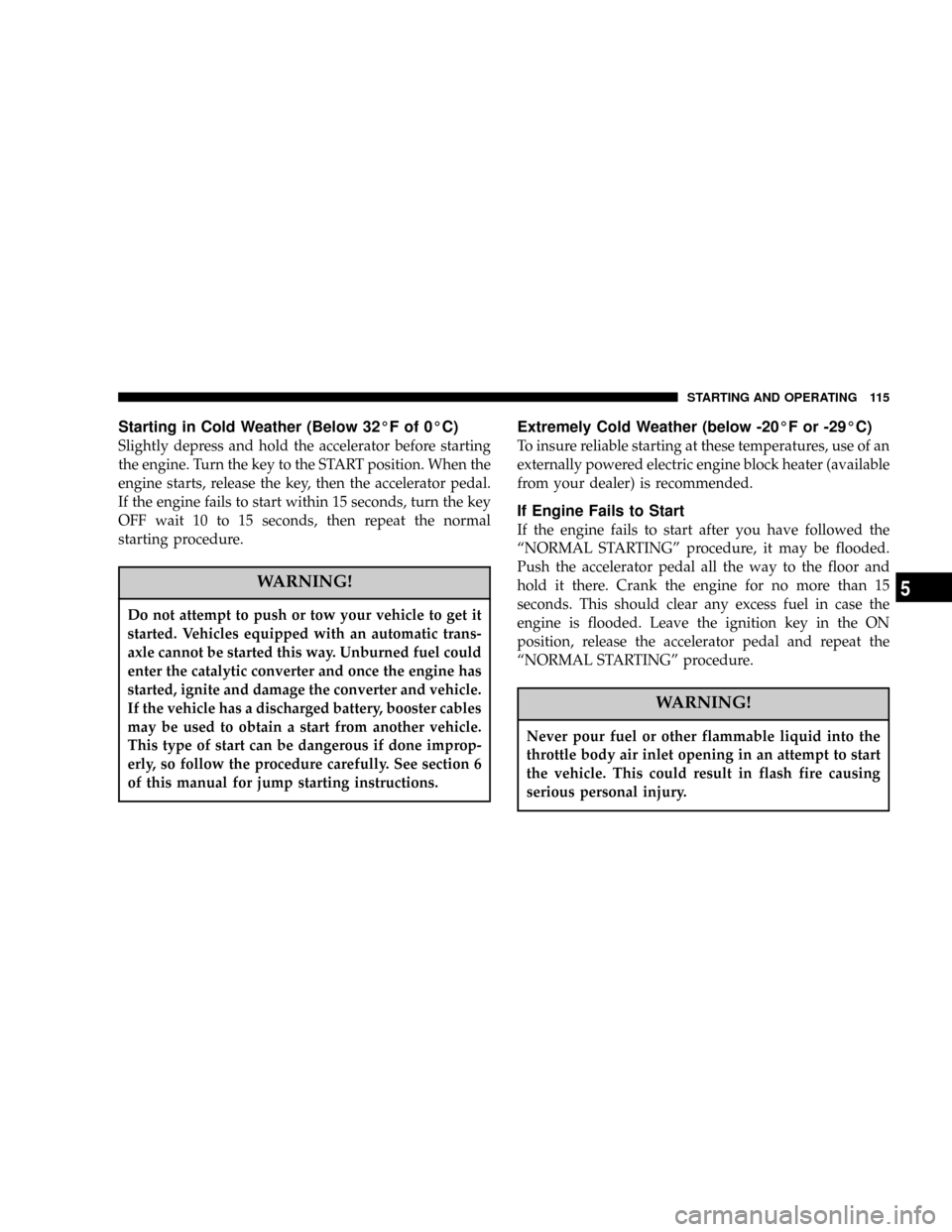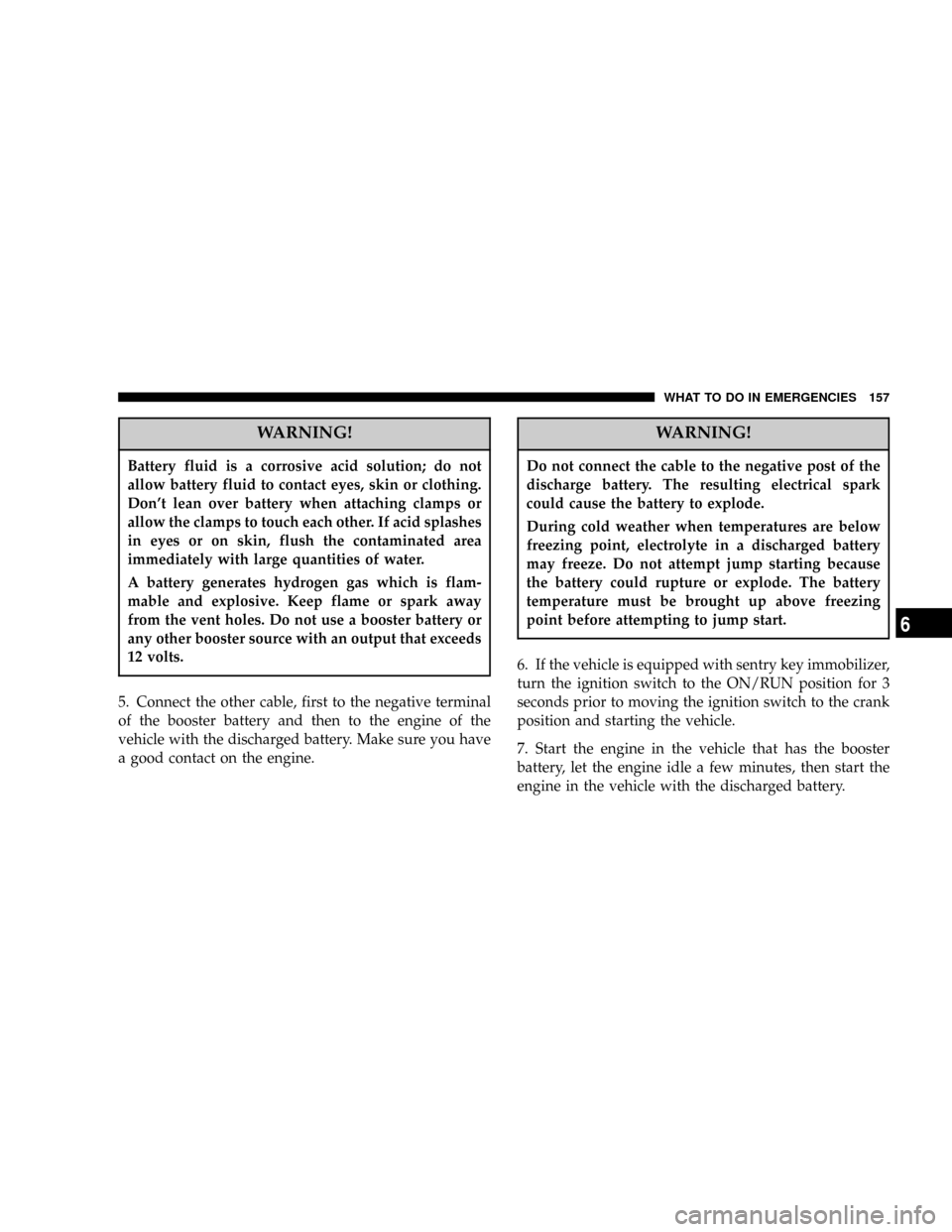2005 DODGE NEON jump start
[x] Cancel search: jump startPage 115 of 246

Starting in Cold Weather (Below 32ÉF of 0ÉC)
Slightly depress and hold the accelerator before starting
the engine. Turn the key to the START position. When the
engine starts, release the key, then the accelerator pedal.
If the engine fails to start within 15 seconds, turn the key
OFF wait 10 to 15 seconds, then repeat the normal
starting procedure.
WARNING!
Do not attempt to push or tow your vehicle to get it
started. Vehicles equipped with an automatic trans-
axle cannot be started this way. Unburned fuel could
enter the catalytic converter and once the engine has
started, ignite and damage the converter and vehicle.
If the vehicle has a discharged battery, booster cables
may be used to obtain a start from another vehicle.
This type of start can be dangerous if done improp-
erly, so follow the procedure carefully. See section 6
of this manual for jump starting instructions.
Extremely Cold Weather (below -20ÉF or -29ÉC)
To insure reliable starting at these temperatures, use of an
externally powered electric engine block heater (available
from your dealer) is recommended.
If Engine Fails to Start
If the engine fails to start after you have followed the
ªNORMAL STARTINGº procedure, it may be flooded.
Push the accelerator pedal all the way to the floor and
hold it there. Crank the engine for no more than 15
seconds. This should clear any excess fuel in case the
engine is flooded. Leave the ignition key in the ON
position, release the accelerator pedal and repeat the
ªNORMAL STARTINGº procedure.
WARNING!
Never pour fuel or other flammable liquid into the
throttle body air inlet opening in an attempt to start
the vehicle. This could result in flash fire causing
serious personal injury.
STARTING AND OPERATING 115
5
Page 149 of 246

WHAT TO DO IN EMERGENCIES
CONTENTS
mHazard Warning Flasher.................150
mIf Your Engine Overheats................150
mJacking And Tire Changing...............152
NPreparations For Jacking................152
NInstructions.........................152
mJump-Starting Procedures If Battery Is Low...155
mDriving On Slippery Surfaces.............158
NAcceleration.........................158NTraction............................159
mFreeing A Stuck Vehicle.................159
mTowing A Disabled Vehicle...............160
NWith Ignition Key.....................160
NWithout The Ignition Key...............161
NTowing This Vehicle Behind Another Vehicle
(Flat Towing With All Four Wheels On The
Ground)............................161
6
Page 155 of 246

100 ft. lbs. (135 N´m). If you are not sure about the
tightness, have them checked with a torque wrench by
your dealer or at a service station.
8. Remove the wheel blocks and lower the jack until it is
free. Stow the lug wrench, replaced tire, and jack. Secure
all parts using the means provided.
WARNING!
A loose tire or jack thrown forward in a collision or
hard stop could endanger the occupants of the ve-
hicle. Always stow the jack parts and the spare tire in
the places provided.
9. Adjust the tire pressure as soon as possible.
NOTE:The spare tire well is designed to hold the
compact spare tire or a deflated (flat) tire. A fully inflated
tire will not fit in the spare tire well.
JUMP-STARTING PROCEDURES IF BATTERY IS
LOW
WARNING!
Take care to avoid the radiator cooling fan whenever
the hood is raised. It can start anytime the ignition
switch is on. You can be hurt by the fan.
WARNING!
Do not attempt to push or tow your vehicle to get it
started. Vehicles equipped with an automatic trans-
axle cannot be started this way. Unburned fuel could
enter the catalytic converter and once the engine has
started, ignite and damage the converter and vehicle.
If the vehicle has a discharged battery, booster cables
may be used to obtain a start from another vehicle.
This type of start can be dangerous if done improp-
erly, so follow this procedure carefully.
WHAT TO DO IN EMERGENCIES 155
6
Page 157 of 246

WARNING!
Battery fluid is a corrosive acid solution; do not
allow battery fluid to contact eyes, skin or clothing.
Don't lean over battery when attaching clamps or
allow the clamps to touch each other. If acid splashes
in eyes or on skin, flush the contaminated area
immediately with large quantities of water.
A battery generates hydrogen gas which is flam-
mable and explosive. Keep flame or spark away
from the vent holes. Do not use a booster battery or
any other booster source with an output that exceeds
12 volts.
5. Connect the other cable, first to the negative terminal
of the booster battery and then to the engine of the
vehicle with the discharged battery. Make sure you have
a good contact on the engine.
WARNING!
Do not connect the cable to the negative post of the
discharge battery. The resulting electrical spark
could cause the battery to explode.
During cold weather when temperatures are below
freezing point, electrolyte in a discharged battery
may freeze. Do not attempt jump starting because
the battery could rupture or explode. The battery
temperature must be brought up above freezing
point before attempting to jump start.
6. If the vehicle is equipped with sentry key immobilizer,
turn the ignition switch to the ON/RUN position for 3
seconds prior to moving the ignition switch to the crank
position and starting the vehicle.
7. Start the engine in the vehicle that has the booster
battery, let the engine idle a few minutes, then start the
engine in the vehicle with the discharged battery.
WHAT TO DO IN EMERGENCIES 157
6
Page 237 of 246

Emergency, In Case of
Jacking............................. 152
Jump Starting........................ 155
Towing............................. 160
Emergency Trunk Release................. 18
Emission Control System Maintenance....167,206
Engine............................... 165
Break-In Recommendations............... 46
Checking Oil Level.................... 169
Compartment........................ 165
Cooling............................ 181
Exhaust Gas Caution.................. 144
Jump Starting........................ 155
Oil ..........................169,202,203
Oil Change Interval................... 170
Oil Filler Cap........................ 172
Oil Filter............................ 203
Oil Selection......................... 171
Oil Synthetic......................... 172
Overheating......................... 150
Temperature Gauge.................... 81
Timing Belt.......................... 174
Exhaust Gas Caution..................46,144Exhaust Pipes......................... 180
Exhaust System........................ 180
Extender, Seat Belt....................... 31
Filters
Air Cleaner.......................... 175
Automatic Transaxle................... 190
Engine Fuel......................... 175
Engine Oil.......................173,203
Flashers
Hazard Warning...................... 150
Flooded Engine Starting.................. 115
Fluid, Brake........................... 203
Fluid Capacities........................ 202
Fluid Leaks............................ 47
Fluid Level Checks
Automatic Transaxle................... 188
Manual Transaxle..................... 190
Fluids............................... 203
Fog Lights...........................62,77
Folding Rear Seat....................... 57
Freeing A Stuck Vehicle.................. 159
Front Suspension Ball Joints............... 178
INDEX 237
10
Page 239 of 246

Interior Fuses.......................... 197
Interior Lights.......................... 60
Intermittent Wipers...................... 64
Introduction............................ 4
Jack Operation......................... 152
Jacking Instructions..................... 152
Jump Starting......................... 155
Key, Programming....................... 12
Key Release Button...................... 10
Key, Replacement....................... 12
Key, Sentry............................ 11
Key-In Reminder........................ 11
Keyless Entry System..................... 19
Keys.................................. 9
Lane Change and Turn Signals.............. 78
Lap/Shoulder Belts...................... 24
LATCH
(Lower Anchors and Tether for CHildren)..... 42
Lead Free Gasoline...................... 141
Leaks, Fluid............................ 47Light Bulbs........................198,199
Lighter, Cigar.......................... 70
Lights................................ 60
Airbag..........................39,47,79
Anti-Lock............................ 77
Brake Warning........................ 77
Center Mounted Stop.................. 201
Daytime Running...................... 62
Dimmer Switch, Headlight.............61,62
Dome............................... 61
Exterior Check........................ 47
Fog ..............................62,77
Headlights On Reminder................ 62
High Beam Indicator................... 78
Instrument Cluster..................... 61
Interior.............................. 60
Lights On Reminder.................... 62
Low Fuel............................ 79
Malfunction Indicator................... 80
Map Reading......................... 60
Oil Pressure.......................... 78
Park................................ 61
Passing............................. 62
INDEX 239
10